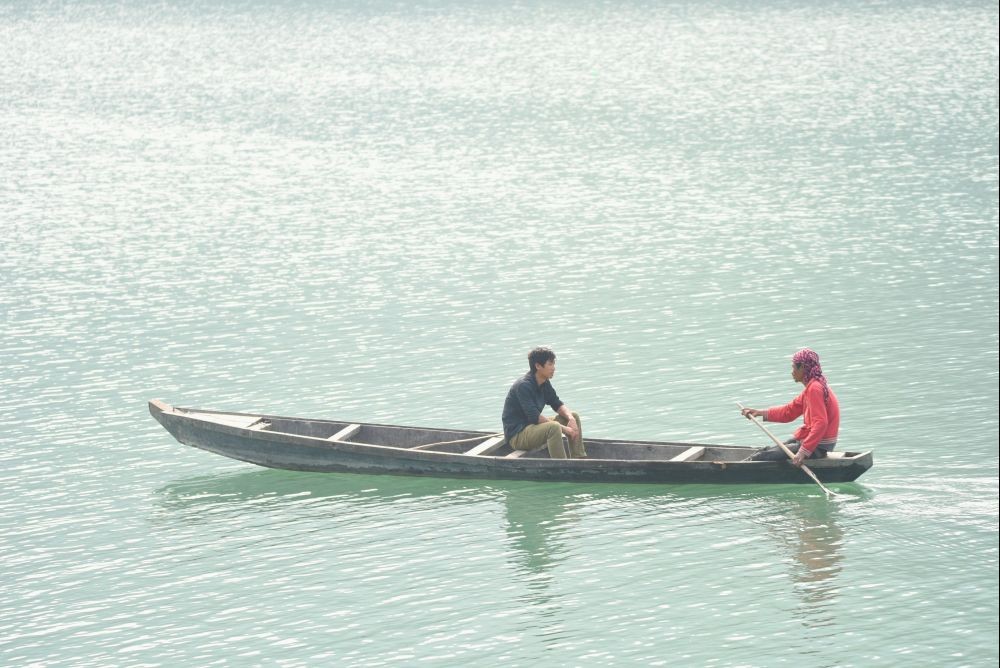Two men are seen in a rowing boat in the Doyang reservoir under Wokha district in Nagaland. (Morung File Photo by Manen Aier)Y

Moa Jamir
Dimapur | August 27
In the last week of June, when the first spell of rainfall hit Dimapur, many residents heaved a sigh of relief at the possibility that their bore-wells would be replenished. Most residents in Nagaland’s commercial capital are dependent on groundwater as a primary water source.
So far, the longest spell of rain was seen from last week of June to first week of July while a short spell was seen last August, Sunit Das of the Indian Metrological Department (IMD), Regional Centre, Guwahati, informed Down To Earth Magazine recently.
Earlier in June, the Department of Agriculture (DoA) informed that the State is witnessing a “drought-like situation” due to delayed and erratic rains since December 2020 to April 2021.
With the onset of South West Monsoon on June 1, the rainfall pattern has improved a bit, but rainfall till August 26 was -24% departure from the normal average.
As per IMD data, from June 1 till August 26, Nagaland recorded only 662 millimeters (mm) against normal rainfall of 875.3 mm. Accordingly, only four districts – Kiphire, Peren, Mon and Mokokchung – have recorded normal rainfall so far.
After analysing the impact on agriculture, The Morung Express looks at the possible impact of deficient rainfall on the state’s water table in the conclusion of this two-part series.
Longer replenishment
In ‘normal years,’ pre-monsoon rains which typically happen between March and May, brings relief to residents after the dry season, but it has not been so for residents in and around 4th Mile, Dimapur.
Groundwater replenishment is at half of what it normally used to be, informed Chubamenla, a resident of Diphupar Dimapur, located near Chathe River. In the adjoining Naga United village, a resident informed that the first ‘heavy’ rainfall was in June.
Reportedly, many residents are changing from tube-wells to bore-wells, which are usually around 150-180 ft deep, due to depleting water resources.
“Even now the water level is yet to return to normal in many household,” said a resident of Mao colony, under Kuda B area of Dimapur. The colony is located along the Dhansiri River Bank.
I had to install an extra ‘hume pipe’ of 10 feet in addition to existing 35 feet, he said, further attributing the fall in water level to increased population along with lesser rainfall.
Chubamenla, who is currently doing her Masters from the North-Eastern Hill University, undertook a survey on groundwater in and around Diphupar for a college project last year.
Out of the 20 respondents she received, all informed that they were facing ‘problem of drying up of the well’ in the recent years. Rating the problem on a scale of 10, a total of 15 respondents said that they were facing in 1-3 range while 5 said that it was in the range of 4-6.
Most agreed that their wells might “dry up completely in the near future.”
‘Supply of water for household purposes in Dimapur is not adequately sustainable as many wells reach quite low levels during the dry season or even dries up. Many households depend on monsoon for the well to be replenished,’ maintained a respondent.
Lack of alternative initiatives by the government or any groups for water supply and management was also highlighted.
Sharing the survey, Chubamenla noted that as the rainfall was lesser this year, the outlook might have changed further.
A resident of Kohima, however, was not necessarily worried. Asked why, he noted that as water scarcity is ‘normal’ in Kohima during winter, it would not be different from other years.
Official records
Such anecdotal observations are confirmed officially. The Annual Administrative Report of Department of Geology & Mining (DGM), 2020-21 informed that due to rapid “depletion of groundwater levels in dense settlement and industrial areas of Dimapur largely due to over-pumping” the department is undertaking ‘identification and construction of Artificial Recharge structures and roof top rainwater harvesting to revive sick wells in industrial area of Dimapur.’
“State-wise Decadal Water Level Fluctuation with Mean [November (2010 to 2019)] and November 2020” given by the Ministry of Jal Shakti in reply to a query in the Lok Sabha on August 5 informed that fall in ground water was observed to be 0-4 metre in the intervening period.
The data base on the Central Ground Water Board (CGWB) periodical monitoring of the ground water levels throughout the country, however, measured two wells.
According to CGWB’s ‘Ground Water Year Book India 2019-20’, it monitored a total of 30 ground water monitoring wells (22 dug wells and 8 Piezometer) in Nagaland.
Nagaland was among 14 states/union territories where the “contribution in Annual Ground Water Recharge from rainfall during monsoon season” was more than 70%.
Elsewhere, the physical progress of the national flagship Jal Jeevan Mission (JJM) aimed at providing Functional Household Tap Connection (FHTC) to every rural household by 2024 is not encouraging so far in Nagaland.
As per the latest JJM Dashboard, out of 2,06,363 households planned to be provided with FHTC in 2021-22, only 25,356 have been covered as on August 27. The progress is just 12.3% of the proposed target. A total 151 villages in Nagaland had 100% FHTC while in 1,107 villages, it was below 70%. In 95 villages, the FHTC coverage ranged from 70-99%.
With deficient rainfall, the prospect of water depletion and more, the State’s citizens in many areas might be looking at possible acute water scarcity in the dry winter season.
Read Related Reports:
Amid deficient rainfall, Nagaland’s sole water reservoir below ‘normal’ storage
‘Drought-like Situation’: Nagaland’s Agri Dept intervention
Deficient rainfall in Nagaland-I: Farmers suffering from losses





.jpg)
